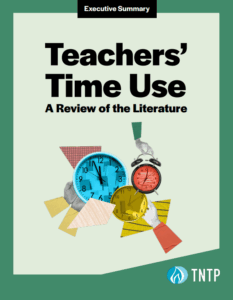Overcoming Absenteeism and Classroom Discipline Challenges
As students struggle to regain ground lost during the pandemic, school leaders nationwide say that chronic absenteeism and discipline challenges are on the rise. Before the pandemic, about 8 million students were considered chronically absent, defined as missing at least 10% of school days in one year. By the spring of 2022, that number had more than doubled, according to Attendance Works. In addition, 70% of educators report that students are misbehaving more now than they were in 2019. Absenteeism and disciplinary action are deeply intertwined issues, resulting in students being removed from learning environments and impeding their access to a quality education.
TNTP recently hosted, “The Empty Seat Epidemic: Overcoming Chronic Absenteeism and Discipline Challenges in Schools,” a webinar exploring strategies for boosting attendance and overcoming discipline issues. Moderated by Bailey Cato Czupryk, TNTP senior vice president of learning, impact, and design, and featuring insights from Kevin Haynes, TNTP director of analytics and community engagement, and Dr. Jason Okonofua of Mindset Science Solutions, the session attracted hundreds of educators, administrators, and advocates from across the country.
“Folks are really feeling the challenge of ensuring that kids are coming to school, that they feel safe and feel like they belong in school,” said Cato Czupryk. To explore these challenges and to surface solutions, we put together key takeaways from the webinar, including two actionable tools that can immediately be put into practice:
“Folks are really feeling the challenge of ensuring that kids are coming to school, that they feel safe and feel like they belong in school.”
—Bailey Cato Czupryk
Chronic Absenteeism Can Impact Students for Life
Children who are persistently absent during the early grades are much less likely to read at grade level by the time they reach third grade. Data from a study of public school students in Utah paints a grim picture: a single year with an incidence of chronic absenteeism between the eighth and twelfth grades was associated with a seven-fold increase in the likelihood of dropping out. The effect of dropping out of high school has been linked to poor outcomes later in life, including high rates of poverty, diminished health, and involvement in the criminal justice system.
Positive Communication Can Raise Attendance Rates
The power of positively framed communication offers a beacon of hope. Sending messages crafted around clear, individualized attendance data can empower families and boost the number of days students spend in school. Inform, a new product from TNTP, provides districts and schools immediate and proactive support in deploying family-facing messages that are positively, not punitively framed.
“That’s part of the key here,” Haynes said. “We’re saying, ‘We can do this together.’” The messages are tiered, so students with standout attendance might get a congratulatory letter, while the families of students who are chronically absent might receive a call to action. TNTP will then batch-process the letters, sending them however the school district chooses. “The idea is to get out in front of these challenges, and to use this simple piece of communication to form a stronger partnership,” said Haynes.
As Haynes explained, Inform came about after data from a Northern California school district showed inconsistent outcomes among students who, on paper, seemed similar. “I brought attendance data into the model, and suddenly the model got more accurate,” he told the audience. “For us, it was one of the first times that we actually quantified the value of a single day of school.” One school in this pilot project saw the year-over-year daily attendance rate climb from 89% to 96%—an astounding improvement with a tangible impact on students’ lives and a significant return on investment for the district given funding implications.
Sidelining Bias with Empathy Mitigates Behavioral Issues
Approaching students’ behavioral issues not from a disciplinary standpoint but with a mindset rooted in empathy and growth, can be transformative. Easier said than done? The Empathic Instruction (EI) approach to managing behavior, co-created by Dr. Okonofua, is increasingly gaining traction, thanks to a series of studies showing that suspension rates fell sharply when teachers implemented EI.
This approach is especially effective for sidelining unintended bias. School disciplinary practices tend to disproportionately affect students of color and students with learning and thinking differences, with educators being more likely to perceive students of color and students with IEPs as “troublemakers” when they misbehave. Once the perception is formed, the students are more likely to be suspended or otherwise removed from the learning environment.
Empathic Instruction can help sideline bias, explained Dr. Okonofua. That is because EI works on the mindset level. Empathic Instruction’s brief online modules remind teachers, “These are children and they’re learning and growing, and, when they misbehave those are teachable moments. You can get in there and do the things you became a teacher to do in the first place.” Embracing this mindset encourages teachers to build stronger relationships and actively learn about their students’ lives. Students, in turn, feel more respected and respond with improved behavior.
These are children and they’re learning and growing, and, when they misbehave those are teachable moments.
In randomized control trials, suspension rates were cut in half when teachers were trained in EI. In another study, districts saw racial disparities in suspensions fall by 45%. Implementing EI also sharply decreased the likelihood that students who had been suspended once would be suspended again. “By virtue of having just one teacher who treated them in a more empathic manner, students were less likely to get in trouble throughout the school day,” Dr. Okonofua said. Researchers followed up over the next year with the students who had received Empathic Instruction and found they were still less likely to be suspended than their peers. “EI has a sticky effect that goes with the students, on into their futures.”
Post-Pandemic Learning Recovery is Within Reach
Estimates indicate that most students missed at least half a year of math learning and a quarter of a year of reading because of the pandemic. With chronic absenteeism and discipline issues on the rise, the time is now to implement interventions that keep all students in school, safe, and learning.
Want to learn more about strategies such as Inform and Empathic Instruction? Contact us to learn how TNTP can support your efforts.







